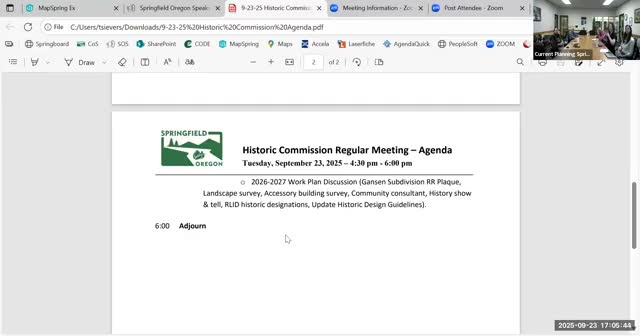Historic Commission lays out potential work-plan projects: tree survey, accessory-building survey, outreach and guideline update
October 13, 2025 | Springfield, Lane County, Oregon
This article was created by AI summarizing key points discussed. AI makes mistakes, so for full details and context, please refer to the video of the full meeting. Please report any errors so we can fix them. Report an error »

At its meeting, the Historic Commission reviewed an 18-month work-plan draft that lists several candidate projects for the commission’s next funding cycle and asked staff to return with cost estimates and recommended priorities at the next meeting.
Key projects discussed:
- Landscape/tree survey: Staff proposed commissioning certified arborists to survey “large established trees” and other notable landscape elements within the Washburn Historic District. Commissioners said the survey should document species, approximate age and locations so the commission could evaluate removal or “radical trimming” requests under the overlay. Staff noted that the city engineer retains authority to approve emergency removals in the public right-of-way; private-property removals in the overlay would still come to the commission for review.
- Accessory-building survey: Commissioners considered a targeted resurvey of accessory structures (sheds, garages, ADUs) that were not captured in prior primary-structure surveys. Staff said many accessory features may have changed since earlier surveys (some dating to the 1980s) and asked whether the commission wants to allocate resources to update the record.
- Community consultant or on-call advisor: The commission discussed a model used in other towns (Independence, Oregon was cited) that places a preservation consultant on retainer or under contract to provide on-site technical advice to homeowners contemplating historic-district changes. Commissioners said a consultant could reduce friction by advising owners before formal applications are submitted and that options range from a paid contractor to a volunteer program.
- History “show-and-tell” and public education: Commissioners proposed education events tied to the forthcoming local atlas and other resources; staff suggested using a general education line item so the commission can fund speakers, tours or museum partnerships without locking into a single program.
- RLID (real-estate listing) historic designation entries: Staff proposed coordinating with the regional data provider (LCOG/ArlID) to add short, standardized historic-district text to property reports so buyers and realtors see overlay notifications at the point of sale.
- Update to the Springfield Historic Design Guidelines: Commissioners noted the existing guidelines date from 2003 and may need revisions to better align guidance with current practice, materials (for example, the role of fiber-cement siding), and the overlay’s legal authority. Commissioners described the task as substantive and requiring subject-matter expertise and legal review.
Staff said the commission has roughly the next cycle to finalize priorities and asked commissioners to review materials and be prepared to set priorities at the October meeting; Tom and staff will assemble proposed budget requests to present for approval at the commission’s early-December meeting. No funding allocations were approved at the meeting; commissioners agreed to discuss priorities and possible budget amounts at the next meeting.
Key projects discussed:
- Landscape/tree survey: Staff proposed commissioning certified arborists to survey “large established trees” and other notable landscape elements within the Washburn Historic District. Commissioners said the survey should document species, approximate age and locations so the commission could evaluate removal or “radical trimming” requests under the overlay. Staff noted that the city engineer retains authority to approve emergency removals in the public right-of-way; private-property removals in the overlay would still come to the commission for review.
- Accessory-building survey: Commissioners considered a targeted resurvey of accessory structures (sheds, garages, ADUs) that were not captured in prior primary-structure surveys. Staff said many accessory features may have changed since earlier surveys (some dating to the 1980s) and asked whether the commission wants to allocate resources to update the record.
- Community consultant or on-call advisor: The commission discussed a model used in other towns (Independence, Oregon was cited) that places a preservation consultant on retainer or under contract to provide on-site technical advice to homeowners contemplating historic-district changes. Commissioners said a consultant could reduce friction by advising owners before formal applications are submitted and that options range from a paid contractor to a volunteer program.
- History “show-and-tell” and public education: Commissioners proposed education events tied to the forthcoming local atlas and other resources; staff suggested using a general education line item so the commission can fund speakers, tours or museum partnerships without locking into a single program.
- RLID (real-estate listing) historic designation entries: Staff proposed coordinating with the regional data provider (LCOG/ArlID) to add short, standardized historic-district text to property reports so buyers and realtors see overlay notifications at the point of sale.
- Update to the Springfield Historic Design Guidelines: Commissioners noted the existing guidelines date from 2003 and may need revisions to better align guidance with current practice, materials (for example, the role of fiber-cement siding), and the overlay’s legal authority. Commissioners described the task as substantive and requiring subject-matter expertise and legal review.
Staff said the commission has roughly the next cycle to finalize priorities and asked commissioners to review materials and be prepared to set priorities at the October meeting; Tom and staff will assemble proposed budget requests to present for approval at the commission’s early-December meeting. No funding allocations were approved at the meeting; commissioners agreed to discuss priorities and possible budget amounts at the next meeting.
View full meeting
This article is based on a recent meeting—watch the full video and explore the complete transcript for deeper insights into the discussion.
View full meeting
